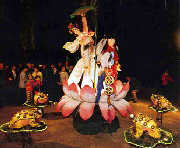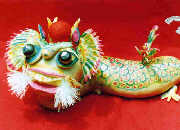 Folk Legends
Folk Legends
 |
| Shehuo (traditional meery-making festivites in vilalge) from Ningxia Volume |
Folk legends, an aesthetically valuable form of literature combining fictional imagination and realistic description on the basis of historical facts, widely spread in China. Chinese folk legends include figure legends and local customs and lifestyles.
Figure legends consists of stories about emperors and generals, national heroes, righteous officials, farmer rebels, revolutionary leaders, men of letters, craftsmen, miraculous doctors, religious figures and so on. Figure legends mainly focus on
 |
| Colored lantern "Liu Hai playing with a Toad" |
diverse historical figures, recording their life and the public's views on them.
Legends of local customs and lifestyles are rich in China and they are the aesthetic interpretation of the origin or names of landscapes, local special produces or customs. Such legends include those about natural phenomenon, artificial scenes, local special produces, and folk customs.
Folk legends such as Tale of the White Snake, Mengjiangnu Crying at the Great Wall, Story of Butterfly Lovers, and The Cowherd and the Weaving-fairy have been told in China for ages.
 Folktales
Folktales
 |
| Gaizhou Shadow Play (Qing Dynasty collection) |
Chinese story-telling dates back to over 2,000 years ago and it is still popular nowadays. It is an important mass entertainment, which sometimes is called "Telling ancient stories", "Telling making-up stories", "Giving Longmenzhen" (Chatting) or "Expounding the text of Buddhism".
Generally Speaking, Chinese Folktales fall into the following categories: Imaginary folktales, life folktales, animal folktales or folk jokes.
Imaginary folktales express good wishes of the people by means of imagination. Usually, there are spirits, magic treasures, immortals, and magic arts in these tales. The representative tales are Seeking Happiness, Snailgirl, Cinderella, Snakeman, Frog Son-in-Law, Dog's Plowing, Wolf Grandmother, Ten Brothers, Leaking House and so on.
 |
| Dough Sculpture "Dragon" from Shanxi Volume |
Life folktales take people of all walks of life as their characters, depict their personalities through literary techniques and surprising plots, and are characterized by realism, irony and criticism. Such tales include those about landlords and long-term hired hands, bight girls or daughters-in-law, stupid sons-in-law or sons, witty figures and so forth.
Animal folktales take animals as their characters and develop the plots based on imagination and aim to entertain, persuade, educate or explain. Human's virtues such as goodness, industry, honesty modesty, gratefulness, helping others, and defects such as cunningness, laziness, crankiness, dishonesty, ungratefulness or selfishness are projected on these animals. These tales reflect the complexity of interpersonal relations by depicting animals' conflicts. The most well known ones are Feud between the Cat and the Dog, Student Tiger, and Tale of 12 Zodiac Animals.
Folk jokes reflect the contradictions in life in the form of caricature-style language; make people laugh by showing the absurd contrasts between sincerity, beauty, and goodness, and show the story-tellers' criticism on and disapproval of falseness, ugliness and evil. Today, folk jokes are still one of the most popular and widely spread folk literature.
